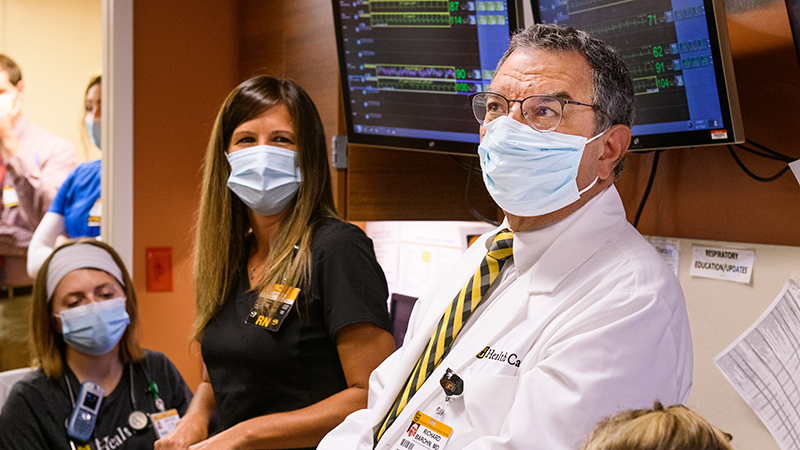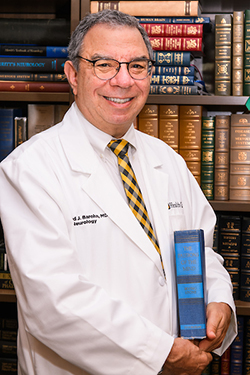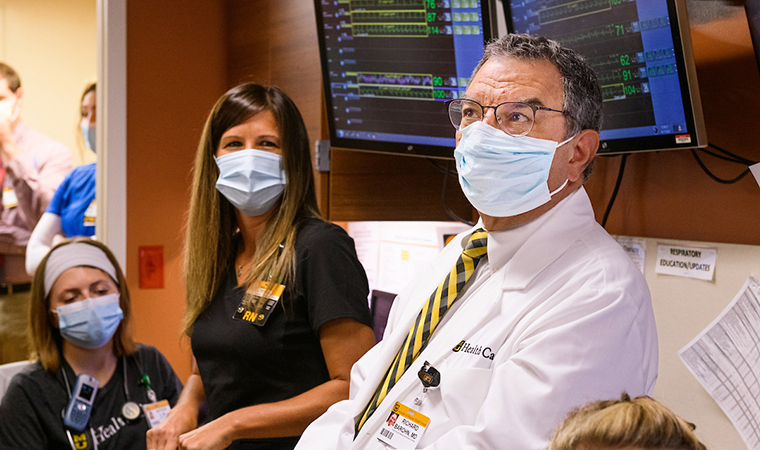
As a 16-year-old boy growing up in the St. Louis suburb of Creve Coeur, Rick Barohn, MD, bought a copy of Irving Stone’s “The Passions of the Mind.” The 800-plus page biographical novel about Sigmund Freud — not exactly typical teenage fare — had a dramatic impact on Barohn’s life. He became so intrigued with Freud that he started thinking about studying brains for a living.
“There was just something about that story that always appealed to me,” Barohn said. “He is still one of my heroes. Freud was a neurologist who did all this neuroscience lab work before he invented this thing called psychotherapy.”

Nearly five decades after reading that book, Barohn is still into brains. Just like his hero, he’s a neurologist who is also an expert in human behavior. Specifically, he has a knack for building and motivating teams that can turn his big dreams into reality.
After spending the previous two decades dramatically enhancing the University of Kansas’ stature in medical research, Barohn joined the University of Missouri in May. As executive vice chancellor for health affairs, he oversees the MU School of Medicine and MU Health Care. He reports directly to University of Missouri System President and MU Chancellor Mun Choi, PhD.
They share an ambitious vision.
“We have very talented faculty, staff and students, and now we have a compelling vision for research in precision health and creative works,” Choi said. “Rick has so much experience at the national level in developing programs of excellence to support multi-institution research and clinical translation. Those are the areas where I want Mizzou to become a national leader.”
Barohn’s new role at MU goes beyond research, of course. He wants to help MU Health Care grow through smart partnerships. He wants the School of Medicine, which consistently exceeds the national average on board scores, to continue what it’s been doing educationally.
It is in the field of medical research, though, where the university system is making an unprecedented investment with the NextGen Precision Health Initiative. The initiative includes the $220 million NextGen Precision Health building that is under construction. Choi has entrusted Barohn as the initiative’s executive scientific director.
A scale model of the NextGen building sits on a table in Barohn’s office. When the building opens in October 2021, his office will be inside. The university is committed to doing more clinical translational research — turning basic science discoveries into therapies that help patients — and Barohn intends to do everything in his power to recruit, retain and support the people who are committed to that mission.
“My career has been about taking advantage of all the opportunities that came my way and then trying to create opportunities for other people and getting them excited about it,” he said. “They feed off my excitement about these projects.”
The Pied Piper
Barohn’s knack for inspiring others begins with his own passion for projects. When a subject captures his interest, he doesn’t let go.
While he was a student at the University of Missouri-Kansas City, where he completed the combined BA/MD program, Barohn joined the Air Force through the military’s Health Professions Scholarship Program. He did it mainly to save his father the expense of paying his tuition, but he loved the Air Force so much that he served a combined 20 years of active and reserve duty and rose to the rank of lieutenant colonel.
Barohn is a hat enthusiast who has dozens in his collection and cannot resist a visit to his favorite haberdashery, Levine Hats, when he’s in St. Louis.
“He probably loves hats too much,” joked Gil Wolfe, MD, the chair of the University at Buffalo’s neurology department and one of Barohn’s frequent research partners, “but he does look good in a hat.”
Barohn is such a baseball fan that he bought Kansas City Royals season tickets while the team was mired in a nine-year stretch of losing seasons. He then enjoyed the good times by attending 61 games during the World Series championship year of 2015.
The only limit on Barohn’s love of art is the amount of wall space in his home and office. He began collecting the works of local artists during his time in Texas, where he started his academic medicine career at the University of Texas-San Antonio and then UT Southwestern in Dallas. At KU, he was chairman of the university’s committee that bought and commissioned art for campus buildings.
Barohn is so passionate about art, he updates an Excel spread sheet titled “Rick’s Museum Ranking System,” which rates the 73-and-counting North American art museums he’s visited. He readily shares the list with friends.
“He doesn’t do anything part way,” said Gary Gronseth, MD, who has known Barohn for 35 years and succeeded him as chair of KU’s Department of Neurology.
As committed as Barohn is to his leisure activities, there is another, higher level reserved for his work. He made a name for himself as a prolific physician-scientist studying and treating neuromuscular diseases, such as amyotrophic lateral sclerosis (ALS), muscular dystrophy and myasthenia gravis.
He published often and organized clinical trials involving more than 40 sites. He found creative ways to expand his vast network of neurologists, including the creation of a website, Rick’s Real Neuromuscular Friends, where more than 2,000 neurologists discuss tough clinical cases and research issues. He started an annual networking dinner for his website members where he hands out gag awards such as “Most Complicated Post.” This year, he and his friends even created their own online medical journal, RRNMF Neuromuscular Journal, that publishes open-access articles at no cost.
“It’s publishing things that other journals have not published or haven’t even conceived of publishing — things like grant proposals that didn’t go through initially,” Wolfe said. “He has very innovative approaches to bringing a community of people together to not only do research and clinical trials but also to compare notes about cases.
“I can’t think of anyone else like him in neurology. He just has that Pied Piper quality. One of my colleagues calls him the Pied Piper of neuromuscular disease.”

‘It’s definitely doable’
At KU, Barohn’s accomplishments and reputation grew beyond the field of neuromuscular research. In 2001, when he accepted the job as chair of the Department of Neurology, he arrived as one of only five physicians in the department. He grew the department to include more than 50 physicians. His strategic hire of an Alzheimer’s disease expert helped KU Medical Center become one of only 32 health systems in the nation designated as a National Institutes of Health Alzheimer’s Disease Center.
Barohn’s most significant achievement at Kansas came in 2011, when he led the team that earned KU a coveted NIH Clinical Translational Research Award (CTSA). The renewable five-year, $25 million grant helped KU develop its clinical and translational science institute, which is known as Frontiers. Barohn had unsuccessfully applied for the grant twice before, but using a leadership style that Gronseth described as equal parts nurturing and nudging, Barohn instilled his passion for the project in the team members, and they won the award.
“When I get an idea in my head that I think is doable, I like to get other people involved and try to take a stab at getting the project done,” Barohn said.
In 2014, Barohn was promoted to vice chancellor of research at KU Medical Center. In six years in that position, he helped the school increase its total research funding from $83.7 million to $131 million.
“You can measure our research capacity change over the arc of his time at KU, both in his own department, in neurology, but also campus-wide as he became the vice chancellor for research and the lead for our CTSA,” said Kim Kimminau, PhD, the associate director of Frontiers. “He’s relentless about advancing research in all the dimensions it takes, including the unexciting but necessary components — like getting grant forms made, routing processes, signoffs — but also the exciting parts, like putting new teams together and hiring new faculty with new ideas. He keeps all of it in play.”
Barohn said one part of increasing the research productivity at MU is motivating doctors and basic scientists to work together to “put more shots on goal” in terms of submitting grants. But it also will require an investment in hiring people with expertise and passion for research. That has already begun. In August, the university announced it had lured medical informatics expert Russ Waitman, PhD, away from KU. Barohn called the hire of Waitman a “major game-changer” and “step one in this process.”
Barohn knows what it takes to build powerful research programs, and he’s all-in on making it happen at the University of Missouri.
“We have amazing resources on this campus,” Barohn said. “It will take five to 10 years to really increase the research productivity, but it’s definitely doable.”





